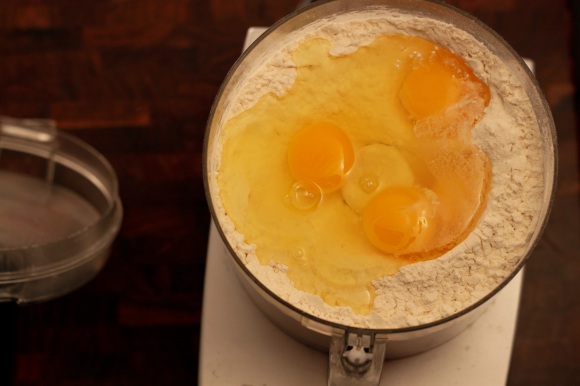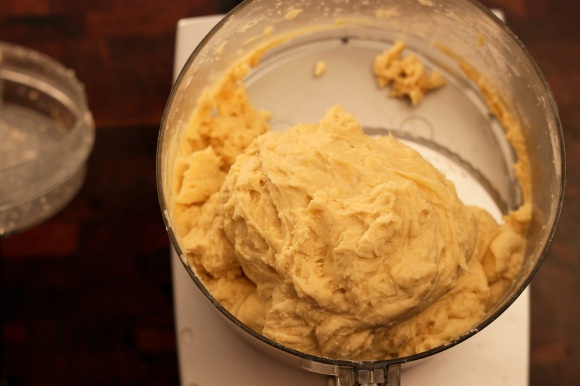Fresh pasta is a thing of simple beauty. The pasta tastes better than store-bought dried pasta, it holds sauce better (which is arguably part of it’s purpose), and sometimes it’s just much more satisfying to enjoy a dish made entirely from scratch. Pasta dough is also very easy to make, especially if you don’t mind getting the food processor dirty.
Traditionally, pasta is made by combining wheat flour and water. The type of flour may vary, and as you can see, the water may come in the form of eggs. I decided to use eggs to add extra flavor and richness to the pasta, but you can use water if you prefer extra simplicity. The flour and water is traditionally mixed by carefully adding the water to a mound of flour, and using your hands to turn the powder into a paste, and then into dough. While I certainly don’t mind getting my hands dirty, I can never avoid a giant mess on my counters. Mixing the flour and water (or eggs) in the food processor makes the entire process cleaner, faster, and more enjoyable (if you don’t like scraping flour-paste off your fingers and counters). Just mix 3.5 cups flour and 4 eggs together in a food processor until a sticky dough forms, which tends to ball up and spin around the top of the bowl.
Once you’re done watching the ball of dough spin around the bowl of the food processor, it’s time to kneed! Just like in bread, pasta dough needs gluten, which allows you to roll it out into smooth and even sheets. The spinning blades of the food processor did some of the kneading for you, but it will take some elbow-grease to make it perfect. Sprinkle a little bit of flour on your counter or cutting board, and rub a little bit of good olive oil on your hands. These will help prevent sticking, while also adding the flavor of the oil into your dough. Knead the dough by using the heel of your hand to push the dough away from you, flattening it on the counter. Then fold it in half, rotate it a little, and flatten it out again. Keep doing this, adding flour and oil as necessary, until the dough is smooth and soft. This usually takes 5-10 minutes.
You can tell if your dough has been kneaded enough by looking for the “window pane”. Pinch off a small piece of dough, flatten it as much as possible in the palms of your hands, and then slowly stretch it out. If you can stretch it thin enough to see lots of light, then it’s ready. If you aren’t sure, just keep kneading. It’s very difficult to over-knead your dough, especially when you are kneading by hand.
Once your dough is thoroughly kneaded, wrap it in some plastic wrap and let it relax in the refrigerator for a few hours. Letting the dough relax will give the gluten time to form longer strands, which will prevent the dough from tearing when you roll it out. If you roll it out right away, it’s much more likely to tear into shreds, which is very disappointing! After a few hours, it’s time to get to the hard part: rolling the pasta! Unfortunately, I was wrist deep in flour and egg-wash (for the ravioli, soon to come), so I didn’t get a picture of the process. If you have a pasta roller, just start on the highest setting (thickest spacing between the rollers), and carefully run a piece of dough through a few times. Using progressively smaller settings, roll the pasta into long sheets of your desired thickness, which will depend on personal taste and ultimate purpose. Remember to keep the dough lightly floured, to prevent sticking.
I used most of the dough to make ravioli, but the rest was left to dry in little nests. I highly encourage you to eat some right away, put this 1 pound batch will go a long way, so unless you’re a traditional Italian family (why would you need to read this?), you will probably have a lot of pasta left over!
If you don’t have a pasta roller, you can use a rolling pin. Just slowly and carefully roll your pasta, and cut it into noodles. Give it a try, and I’m sure you’ll invest in a pasta roller!
Note: Don’t dry the pasta noodles in clumps. They don’t cook properly: the outsides over cook as the boiling water very slowly penetrates the dense interior. I found this out the hard way, but I blame Uncle Joel, since he was too lazy to help me finish the rolling out the ravioli…




Hmmmm what a delicious pasta I want like to eat it all. http://belottirb.com/